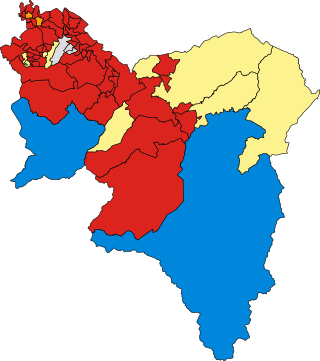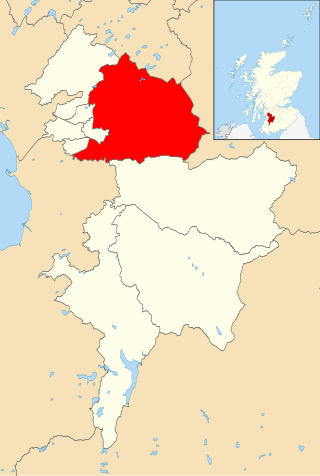
Elections to South Lanarkshire Council were held on 1 May 2003, the same day as the 31 other local government elections in Scotland and elections to the Scottish Parliament. This was the third election since the council's creation in 1995 and the last election to use first-past-the-post voting.
Elections to East Ayrshire Council were held on 1 May 2003, the same day as the 31 other local government elections in Scotland and elections to the Scottish Parliament. This was the third election since the council's creation in 1995 and the last election to use first-past-the-post voting.
Elections to Cumnock and Doon Valley District Council were held on 3 May 1977, on the same day as the other Scottish local government elections. This was the second election to the district council following the local government reforms in 1974.

Irvine Valley is one of the nine electoral wards of East Ayrshire Council. Created in 2007, the ward elects three councillors using the single transferable vote electoral system. Originally a four-member ward, Irvine Valley was reduced in size following a boundary review and has elected three councillors since the 2017 East Ayrshire Council election.

Ballochmyle is one of the nine electoral wards of East Ayrshire Council. Created in 2007, the ward elects four councillors using the single transferable vote electoral system and covers an area with a population of 13,990 people.

Cumnock and New Cumnock is one of the nine electoral wards of East Ayrshire Council. Created in 2007, the ward elects four councillors using the single transferable vote electoral system and covers an area with a population of 13,210 people.
Elections to East Ayrshire Council were held on 6 May 1999, alongside elections to the Scottish Parliament. This was the second election following the local government reforms in 1994 and the first following the Third Statutory Reviews of Electoral Arrangements which resulted in two additional seats from the previous election.
Mauchline was one of 32 electoral wards of East Ayrshire Council. Originally created in 1974, the ward was initially within Cumnock and Doon Valley District Council before the local government reforms in the 1990s. The ward elected one councillor using the first-past-the-post voting electoral system.
Patna and Dalrymple was one of 32 electoral wards of East Ayrshire Council. Originally created in 1974, the ward was initially within Cumnock and Doon Valley District Council before the local government reforms in the 1990s. The ward elected one councillor using the first-past-the-post voting electoral system.
Dalmellington was one of 32 electoral wards of East Ayrshire Council. Originally created in 1974, the ward was initially within Cumnock and Doon Valley District Council before the local government reforms in the 1990s. The ward elected one councillor using the first-past-the-post voting electoral system.
New Cumnock was one of 32 electoral wards of East Ayrshire Council. Originally created in 1974, the ward was initially within Cumnock and Doon Valley District Council before the local government reforms in the 1990s. The ward elected one councillor using the first-past-the-post voting electoral system.
Muirkirk, Lugar and Logan was one of 32 electoral wards of East Ayrshire Council. Originally created in 1974 as Lugar, Logan and Muirkirk before being renamed in 1999, the ward was initially within Cumnock and Doon Valley District Council before the local government reforms in the 1990s. The ward elected one councillor using the first-past-the-post voting electoral system.
Auchinleck was one of 32 electoral wards of East Ayrshire Council. Originally created in 1974, the ward was initially within Cumnock and Doon Valley District Council before it was abolished in 1984. Following the local government reforms in the 1990s, the ward was reestablished in 1999 as part of East Ayrshire. The ward elected one councillor using the first-past-the-post voting electoral system.
Catrine and Sorn was one of 10 electoral wards of Cumnock and Doon Valley District Council. Created in 1974, the ward elected one councillor using the first-past-the-post voting electoral system.
Cumnock East was one of 32 electoral wards of East Ayrshire Council. Originally created in 1984, the ward was initially within Cumnock and Doon Valley District Council before the local government reforms in the 1990s. The ward elected one councillor using the first-past-the-post voting electoral system.
Catrine, Sorn and North Auchinleck was one of 30 electoral wards of East Ayrshire Council. Originally created in 1984, the ward was initially within Cumnock and Doon Valley District Council before the local government reforms in the 1990s. The ward elected one councillor using the first-past-the-post voting electoral system.
Drongan, Stair and Rankinston was one of 32 electoral wards of East Ayrshire Council. Created in 1999, the ward elected one councillor using the first-past-the-post voting electoral system.
Ochiltree, Skares, Netherthird and Craigens was one of 32 electoral wards of East Ayrshire Council. Created in 1999, the ward elected one councillor using the first-past-the-post voting electoral system.
Cumnock West was one of 32 electoral wards of East Ayrshire Council. Created in 1999, the ward elected one councillor using the first-past-the-post voting electoral system.
Hillhouse was one of 67 electoral wards of South Lanarkshire Council. Originally created in 1974, the ward was initially within Hamilton District Council before the local government reforms in the 1990s. The ward elected one councillor using the first-past-the-post voting electoral system.



